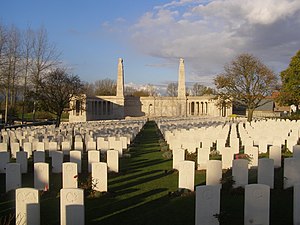| Revision as of 17:44, 28 December 2009 editCarcharoth (talk | contribs)Administrators73,578 edits ←Redirected page to Vis-en-Artois British Cemetery, Haucourt | Latest revision as of 22:32, 8 February 2018 edit undoPrimeBOT (talk | contribs)Bots2,053,271 editsm →top: replace broken CWGC URLs - BRFA | ||
| (19 intermediate revisions by 10 users not shown) | |||
| Line 1: | Line 1: | ||
| {{Infobox Military Memorial | |||
| ⚫ | |||
| |name=Vis-en-Artois Memorial | |||
| |country=] | |||
| |image=] | |||
| |caption=View of the cemetery with the memorial in the background | |||
| |commemorates=forces of the United Kingdom and South Africa | |||
| |unveiled=4 August 1930 | |||
| |coordinates={{coord|50|14|46.56|N|02|57|00.47|E|scale:2500|display=inline,title}} | |||
| |designer=J. R. Truelove (architect)<br>] (sculptor) | |||
| |inscription=To the Glory of God and to the memory of 9903 officers and men of the forces of Great Britain, Ireland and South Africa who fell during the Advance to Victory in Artois and Picardy whose names are here recorded but to whom the fortune of war denied the known and honoured burial given to their comrades in death. | |||
| |source={{cwgc cemetery|79200}} | |||
| }} | |||
| The '''Vis-en-Artois Memorial''' is a ] ] located near the commune of ], in the ] département of ]. The memorial lists 9,843 names of British and South African soldiers with no known grave who were killed during the ], from 8 August 1918 to the ] (11 November 1918). The area of the frontline covered is described as ''"in Picardy and Artois, between the Somme and Loos"''. Canadian, Australian and New Zealand forces that fell during this period and were not found, are commemorated elsewhere on other memorials to the missing.<ref name=cwgc> Commonwealth War Graves Commission. Retrieved 28 December 2009.</ref><ref name=ww1> World War I Cemeteries. Retrieved 28 December 2009.</ref> | |||
| The memorial has a screen wall in three parts on which are carved the names of the missing listed by regiment. The central screen is flanked by 70-foot high columns, with a Stone of Remembrance at centre. The carvings include one representing ]. The memorial was designed by the architect J. R. Truelove, with sculpture by ]. The memorial was unveiled on 4 August 1930 by the Rt. Hon. ]. Shaw, a ] MP and cabinet minister, was present in his role as British ]. Also present was General ], who had served in the Mediterranean and on the Western Front during the war.<ref name=cwgc/><ref name=ww1/> | |||
| ==See also== | |||
| ⚫ | *] | ||
| ==References== | |||
| {{reflist}} | |||
| ==External links== | |||
| * (includes the dedicatory inscription) | |||
| {{World War I War Memorials in France}} | |||
| ] | |||
| ] | |||
| ] | |||
| ] | |||
Latest revision as of 22:32, 8 February 2018
| Vis-en-Artois Memorial | |
|---|---|
| Commonwealth War Graves Commission | |
 View of the cemetery with the memorial in the background View of the cemetery with the memorial in the background | |
| For forces of the United Kingdom and South Africa | |
| Unveiled | 4 August 1930 |
| Location | 50°14′46.56″N 02°57′00.47″E / 50.2462667°N 2.9501306°E / 50.2462667; 2.9501306 |
| Designed by | J. R. Truelove (architect) Ernest Gillick (sculptor) |
| To the Glory of God and to the memory of 9903 officers and men of the forces of Great Britain, Ireland and South Africa who fell during the Advance to Victory in Artois and Picardy whose names are here recorded but to whom the fortune of war denied the known and honoured burial given to their comrades in death. | |
| Statistics source: Cemetery details. Commonwealth War Graves Commission. | |
The Vis-en-Artois Memorial is a World War I memorial located near the commune of Vis-en-Artois, in the Pas-de-Calais département of France. The memorial lists 9,843 names of British and South African soldiers with no known grave who were killed during the Advance to Victory, from 8 August 1918 to the Armistice (11 November 1918). The area of the frontline covered is described as "in Picardy and Artois, between the Somme and Loos". Canadian, Australian and New Zealand forces that fell during this period and were not found, are commemorated elsewhere on other memorials to the missing.
The memorial has a screen wall in three parts on which are carved the names of the missing listed by regiment. The central screen is flanked by 70-foot high columns, with a Stone of Remembrance at centre. The carvings include one representing St George and the Dragon. The memorial was designed by the architect J. R. Truelove, with sculpture by Ernest Gillick. The memorial was unveiled on 4 August 1930 by the Rt. Hon. Thomas Shaw. Shaw, a Labour Party MP and cabinet minister, was present in his role as British Secretary of State for War. Also present was General Walter Braithwaite, who had served in the Mediterranean and on the Western Front during the war.
See also
References
- ^ Vis-en-Artois Memorial. Commonwealth War Graves Commission. Retrieved 28 December 2009.
- ^ Vis-en-Artois Memorial. World War I Cemeteries. Retrieved 28 December 2009.
External links
- Photographs of the cemetery and memorial (includes the dedicatory inscription)